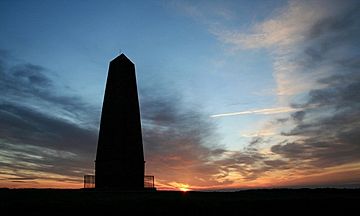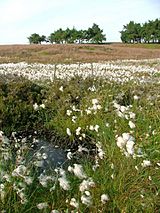Easby Moor facts for kids
Quick facts for kids Easby Moor |
|
|---|---|

Captain Cook's monument on Easby Moor
|
|
| Highest point | |
| Elevation | 324 m (1,063 ft) |
| Prominence | 104 m (341 ft) |
| Geography | |
| Location | North York Moors, England |
| Parent range | Cleveland Hills |
| OS grid | NZ590101 |
| Topo map | OS Landranger 93 |
Easby Moor is a hill found in the North York Moors National Park in North Yorkshire, England. It's part of the Cleveland Hills. At the very top of the hill, which is 324 metres (1,063 ft) (about 1,063 feet) above sea level, stands a monument. This monument honors Captain James Cook, a famous explorer who was born nearby.
The popular walking path called the Cleveland Way goes right over Easby Moor. From the moor, you can look down and see the villages of Easby, Great Ayton, and Little Ayton.
What Happened on Easby Moor?
Easby Moor was the location of an airplane crash during the Second World War. This happened early in the morning on February 11, 1940. A Hudson aircraft took off from Thornaby airfield. Its mission was to look for German ships near the Danish coast.
Just five minutes after taking off, the plane crashed on Easby Moor. Sadly, three of the four crew members died, and the fourth was injured. The plane crashed because ice had formed on its wings. This made it unable to fly high enough to get over the hill. The aircraft went through a group of larch trees before stopping. The empty space in the trees today matches the plane's wingspan, which was about 65.5 feet.
The aircrew who died were Flying Officer Tom Parker, Sergeant Harold Berksley, and Corporal Norman Drury. Leading Aircraftman Athol Barker survived the crash. However, he was later shot down while flying over Germany. The four unexploded bombs the Hudson plane was carrying were later safely set off by the RAF. This created a small pond on the moor.
Captain Cook's Monument
A tall monument stands on Easby Moor. It was built in 1827 by Robert Campion, a banker from Whitby. The monument is 60 ft (18 m) (about 18 meters) high. It has a special plaque with words written on it.
The plaque remembers Captain James Cook, a very famous explorer. It says he was excellent at sailing and exploring. He was brave and visited many new places, like the Friendly Isles (now called Tonga). Captain Cook was born in Marton on October 27, 1728. He was sadly killed in Hawaii on February 14, 1779. The plaque says that as long as people explore and sail, Captain Cook's name will be remembered as one of the greatest helpers of humankind.
This message on the plaque was added later. It was written by George Young (Presbyterian minister), who was also from Whitby. The original message was simpler and mentioned that Robert Campion laid the first stone of the monument on his birthday in 1827. It also noted that Captain Cook was born nearby and learned to sail from Whitby.
Fixing the Monument
In 1895, the monument was fully repaired. This happened after a newspaper, the North-Eastern Daily Gazette, campaigned for it. Workers fixed the stonework and added a lightning conductor. A lightning conductor helps protect tall structures from lightning strikes.
Later, the monument's lightning conductor was stolen. In 1960, lightning struck the monument, causing a lot of damage. It split the stonework from top to bottom. Luckily, work was quickly done to repair the monument and make it strong again.



